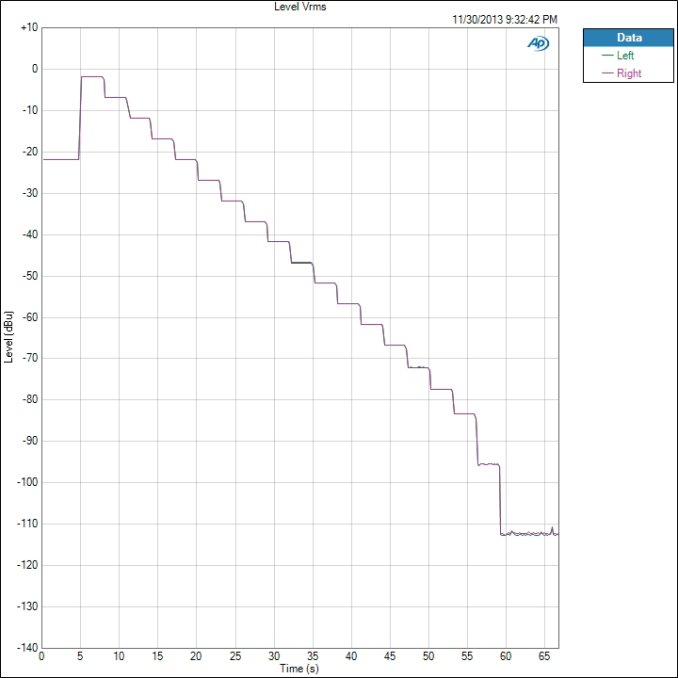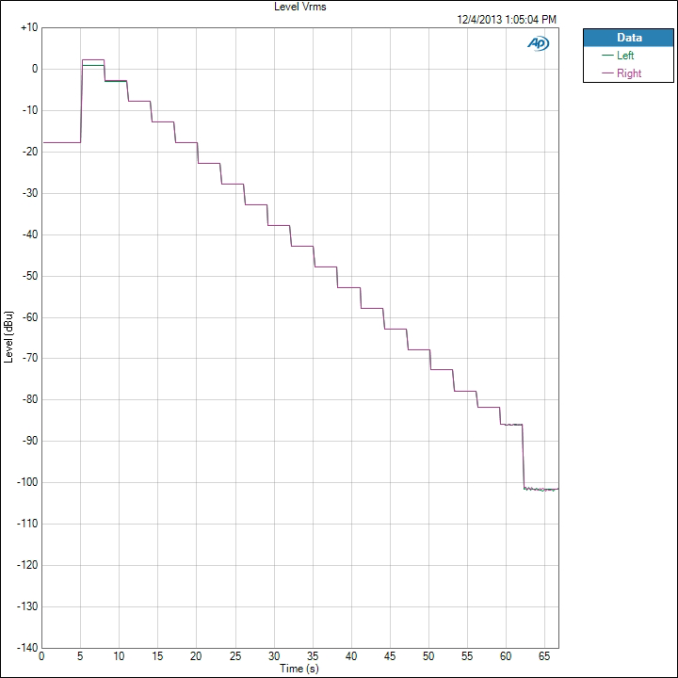Smartphone Audio Quality Testing
by Chris Heinonen on December 8, 2013 5:15 PM EST- Posted in
- Smartphones
- Audio
- Mobile
- Tablets
- Testing
Dynamic Range
The dynamic range of the phone indicates the difference between the loudest possible sound and the background noise. The more residual noise in the background, the lower the dynamic range. Phones with more powerful amplifier sections will typically produce a greater dynamic range. The residual noise level is often constant, so as the overall volume level increases the difference between the music and the noise increases as well.
The best performer here is the iPhone 5 again, with 92.214 dB of range. The worst is the Nexus 5 with only 89.332 dB. A difference of 3 dB is not something I would concern myself over. If we see a phone or tablet that drops down below 80 dB then I will start to show more concern.
Crosstalk
Crosstalk, like dynamic range, is just a number here. This is the measurement how much signal leaks from one channel into another. If an instrument should only be in the right ear, some of that signal will leak into the left ear, but we want that as low as possible. The results are expressed in -dB, or how much quieter one ear is than the intended ear.
On the Note 3 we see a wonderful crosstalk measurement of -117.2 dB so the sounds in one ear are -117 dB quieter in the other ear. This makes them impossible to hear. The worst is the iPhone 5, with only -75.624 dB of isolation.
Stepped Response
The stepped response uses a 1 kHz 0 dBFS tone but measures output level from maximum volume to minimum volume. We can see how large the volume steps are and how many there are. It doesn’t produce a number we can use, but it ties back into our other results. For a good example, we can look at the Note 3.
We see steps that are around -5 dBu each. The final level is muted and just the background noise of the device. Each step is clean and even but as we get lower and lower we see noise start to intrude. This is the background noise starting to become audible in the signal. The flatter the levels are, the quieter it will be. Now, let us look at the Nexus 5.
Notice at the very top how the right and left channels do not overlap. That is the clipping we talked about at the very beginning. It isn’t until the 4th volume setting that the level difference is down to nothing. Because of this, I would consider the top 3 volume settings of the Nexus 5 as ones that should be avoided. They each have enough THD+N introduced into them that it will sound poor, and one ear will be louder than the other.












188 Comments
View All Comments
dylan522p - Sunday, December 8, 2013 - link
Just because you have a good DAC,doesn't mean you have great audio. S4 has a great DAC but it can't even power high impedence headphones.cjl - Monday, December 9, 2013 - link
The S4 powers moderately hard to drive headphones just fine - sure, it won't drive something like an HD650 adequately, but the majority of consumer headphones out there will go plenty loud driven straight out of an S4. That having been said, it would be nice if it had a bit more power for hard to drive headphones.oktrav - Monday, December 9, 2013 - link
I can't believe how many people on the internet are singing this song... Does it really matter who makes the DAC if the output sounds like crap? The DAC is just one of many components that affect the sound quality. You can have the best components in the world and still produce absolutely dreadful sound. Ask any wannabe audiophile who's dabbled in assembling home systems out of separates. This is akin to saying that your car must be very powerful BECAUSE it has Bosch coil packs --and Bosch makes the BEST coil packs (just play along for the sake of the analogy, I'm not actually asserting that Bosch makes the best coils --I don't know).nomopofomo - Sunday, December 8, 2013 - link
So glad you went into such depth.Best case scenario, the public and manufacturer are both made aware of the flaws.
drwho9437 - Sunday, December 8, 2013 - link
This has been needed badly for some time. Phones displacing media players this matters a whole lot. To me far more than actually anything else about a phone.probedb - Sunday, December 8, 2013 - link
You also have to remember with some measurements about what is actually audible and what isn't. It's crazy seeing people moaning about nanoseconds of jitter on DACs yet they're quite happy with milliseconds of the equivalent of jitter on vinyl. Then again some of these companies sell ethernet cable at £1600/m and claim it makes a difference to sound ;)matagyula - Sunday, December 8, 2013 - link
Great to see something like this on anand!I would like to see some older high-end phones compared to the ones we have now - for example the Nokia N900, or maybe even some of the ooold Sony-Ericsson Walkman phones (W810 and up). I'd find such comparison interesting ^^
chubbypanda - Monday, December 9, 2013 - link
Great stuff Chris!I was also wondering if it's possible to add some ancient phone with cult following from audio geeks. You know, Nokia N91 and similar. According to some, sound quality on the phones were never better, so that'd be nice to see what is really happening.
wrkingclass_hero - Sunday, December 8, 2013 - link
So, how long before Arstechnica "discovers" the audio problems with the Nexus 5?crabperson - Sunday, December 8, 2013 - link
YES! Thank you so much for doing this, its awesome. I didn't realize audio/amp quality was a huge thing until I upgraded my headphones. Being able to hear the difference between the same audio file on two different devices made me realize how little manufacturers care about audio quality.Then using an FM transmitter in my car showed me how some devices can't pump out enough power over the headphone jack. My Galaxy Nexus has pretty good audio quality (and does optical audio out through the dock, also awesome) served me fine for pumping up music through the FM transmitter. The Galaxy S3 I'm temporarily using does not though, and produces noticeable clipping at max volume. It also isn't properly shielded and when charging there is interference on the headphone jack (something you should also test if you haven't thought of it). I'm looking at upgrading if I can't fix my Nexus, and hope the HTC One is as good as it in terms of audio quality (with Beats disabled of course).